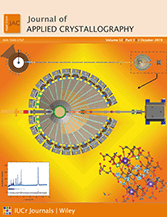issue contents
June 2024 issue
Early view articles

research papers
Open  access
access
 access
accessThe protein complex crystallography beamline BL19U1 is preparing for the establishment of an automated drug screening platform by upgrading both hardware and data collection control systems to optimize efficiency. The upgrade of the experimental station devices and data collection control system on the BL19U1 beamline are reported in this paper.
Open  access
access
 access
accessA new 2D representation of 3D material textures based on the Clifford torus is presented.
Open  access
access
 access
accessA tomography-based ray-tracing approach for analytical absorption corrections for X-ray crystallography is presented. Several examples from long-wavelength macromolecular crystallography experiments demonstrate the efficacy of this new method.
Bi2SiO5 thin films on Nb-doped (111), (110) and (111) SrTiO3 substrates exhibit ferroelectric and energy storage characteristics influenced by their various crystallinities.
Download citation


Download citation


This report describes an `order–disorder' transition in the recently discovered K2Ca3(CO3)4 material and the disordered β modification with an unusual K–Ca isomorphism in cation sites. The appearance of mixed K/Ca sites, in turn, causes strong orientational disorder of anions and the emergence of an inversion center (the ordered α modification is non-centrosymmetric).
Open  access
access
 access
accessBragg Spot Finder (BSF) is a U-Net-based spotfinder with image preprocessing, a U-Net segmentation backbone, and post-processing that includes artifact removal and watershed segmentation. BSF is supported by the Bragg Spot Detection (BSD) benchmark image dataset containing more than 300 images with more than 66 000 spots.
short communications
Open  access
access
 access
accessA 3D-printed in situ crystallization plate is presented, which can be used to probe protein microcrystals in an external electric field.
computer programs
A computer program called Multifitting, which was developed to model the optical properties of multilayer films over a wide range of wavelengths, is described here. Its key features are the ability to work simultaneously with an arbitrary number of reflectometric and scatterometric experimental curves, and an ergonomic graphical user interface that is designed for intensive daily use in the characterization of thin films.
iModel is a 3D crystal structure visualization program that allows users to manipulate and customize models. Developed using LabVIEW and Python, it is a potentially powerful tool for crystal structure visualization.

 journal menu
journal menu





























